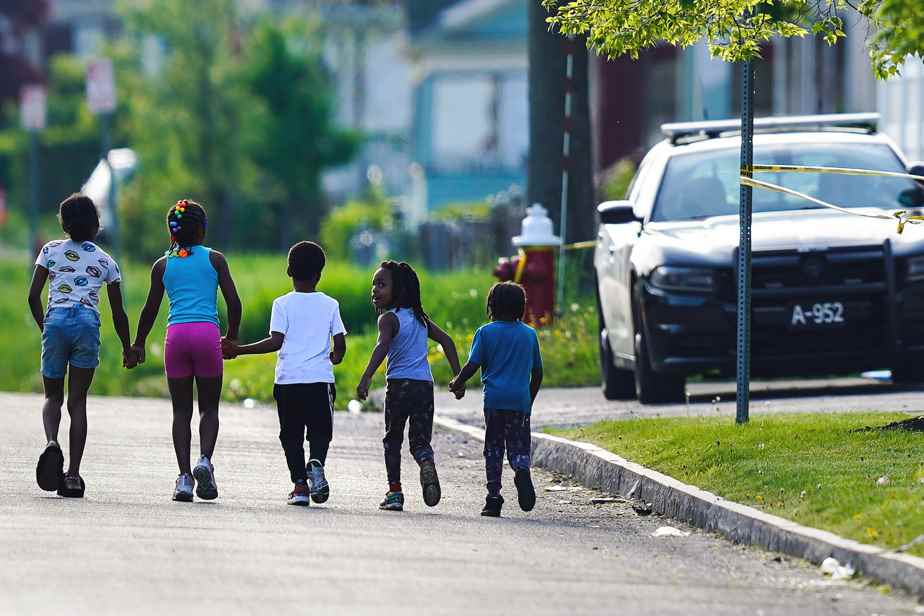Two mass shootings, one in Buffalo, New York, and the other in Uvalde, Texas, have brought gun violence back to the forefront of the American media scene.
Posted May 29
Homicides, killings, suicides, accidents: gun violence was responsible for more than 45,000 deaths in 2020 and can be considered a societal virus that primarily affects people living in precariousness. Racism, poverty and extremism exacerbate this violence, which weapons render more lethal.
Crime in the United States is similar to that in other Western countries, but more deadly. The fact that firearms, rather than car crashes, are now the number one killer of Americans aged 19 and under is a reminder of the inherent dangerousness of these items. An altercation between neighbors, a fight between criminals or the actions of a lone wolf can cause a greater number of victims if the protagonists have access to one or more firearms. The permissive legislation of several states also contributes to the phenomenon: some governments, like that of Missouri, which have adopted laws facilitating the use of firearms for personal defense have seen their homicide rate increase.

Photo Ashlee Rezin Garcia, Associated Press archive
Gun violence was responsible for more than 45,000 deaths in the United States in 2020.
The weapon, status symbol and tool
Since the early 2000s, protection has replaced leisure as the main reason for getting a firearm. This need creates a Catch-22 among gun owners: the individual arms himself because he has to protect himself from people who are armed. The more armed individuals there are, the greater the need to be ready to defend oneself. This results in a state of hypervigilance in which the search for threats – real, potential, imagined – increases the risk of violence. The weakening of the legislative framework in several States over the past 30 years accentuates this need for individual protection since it is relatively easy to obtain firearms. In the same vein, the individual equips himself with increasingly powerful weapons, but is aware that these are also accessible to those who can threaten him. This discourse is of course fueled and instrumentalized by the industry, the pro-firearms lobby, as well as certain media and politicians.
When endemic, the virality of gun violence also results in the disintegration of urban and social fabrics.
Fear drives businesses to close, jobs disappear and people turn to crime for lack of opportunity. In affected communities, children perform less well in school because, although they have not witnessed or experienced gun violence, the protective behaviors they have adopted take up much of their daily attention.
-

Photo Tyler Pasciak LaRiviere, Associated Press archives
Chicago police inspect the scene of a May 10 shooting
-

Photo TODD HEISLER, New York Times archive
Protest in 2016 in Chicago, a metropolis that has seen a marked resurgence of gun violence in recent years.
1/2
Studies conducted in Chicago show that many children suffer from post-traumatic stress disorder, a diagnosis that increases among victims or witnesses of violence. The fear of the lethality of firearms, like a virus, affects all of the communities that experience it.
The effect of the pandemic
COVID-19 has exacerbated the problems associated with this violence. As soon as the first health measures were put in place, thousands of Americans rushed to firearms retailers, which sold nearly 20 million in 2020, 15 million more than usual. The need to ensure his safety in the event of a breakdown of public order was at the heart of this frenzy.
The 2020 homicide rate is up 35% from 2019, unseen since the 1960s. And 77% of homicides were committed with a firearm.
The measures put in place to combat the epidemic have isolated individuals. In communities living in greater precariousness, the individuals most at risk no longer had access to the resources that supported them formally and informally. Suddenly deprived of their friends, families, neighbours, schools, teachers, employers or street workers, they turned to alternative resources and some found themselves on the path to crime.
This isolation, sometimes forcing individuals to establish or maintain their social ties through screens, has increased the influence of social networks and virtual space. The public and permanent character of what takes place there accentuates the conflicts, insults, challenges or exploits, multiplying the direct interactions and the immediate answers, which makes them impossible to ignore. Virtual disputes spread faster and more widely, and online rhetoric reaches extremes faster. Tragically, for some individuals, the disputes that take place there translate into violence in the streets. If a firearm is found at the scene of an altercation, the likelihood of the altercation ending in homicide is increased tenfold, particularly if the weapon is illegally possessed.
Closer than you think

Photo Patrick Sanfaçon, La Presse archives
Illegal weapons seized by Longueuil police in 2016
There are approximately 400 million guns in circulation in the United States. The laxity with which this arsenal is supervised by the authorities explains the smuggling that fuels firearm violence in Quebec and Canada. Between 2014 and 2020, 4,000 guns were seized at the Canada-US border. This is only a fraction of contraband. For the period 2018-2019, the Bureau of Alcohol, Tobacco, Firearms and Explosives confirmed the American provenance of 7,294 weapons found at Canadian crime scenes.
For further
Suggestions by Francis Langlois
- Didier Combeau, Americans and guns. Democracy and violence in the United StatesBelin, 2007.
- Philip J. Cook and Kristin A. Goss, The Gun Debate, What Everyone Needs to KnowOxford U. Press, 2020.
- Michael Kirk, “Gunned Down: The Power of the NRA”, Frontline, PBS, 2015, and “NRA Under Fire”, Frontline, PBS, 2020.
- Francis Langlois, “The United States: Epicenter of Arms Trafficking in America”, Les grands dossiers de Diplomacy 66 (March-April 2022).

